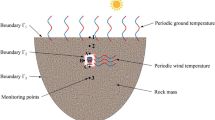Abstract
The increase of mining depth of mines causes the rising temperature of surrounding rocks, especially the non-steady heat dissipation of surrounding rocks in roadways, which is influenced by multiple factors. By establishing a mathematical model for non-steady heat dissipation of surrounding rocks in mines, the main factors (including lithology of surrounding rocks, ventilation velocity, equivalent radius and ventilation time of roadway) influencing the wall temperature and heat dissipation capacity of surrounding rocks were determined. The relationship between wall temperature and surrounding rock heat dissipation with various influencing factors was analyzed. The research results show that it can be seen that under the influences of different lithology, equivalent radius and ventilation velocities, the wall temperature of surrounding rocks constantly declined, while the heat dissipation capacity of surrounding rocks rose at first and then decreased, with the prolongation of ventilation time. And there is a maximum value of heat dissipation in surrounding rock. By calculating the maximum of heat dissipation capacity of surrounding rocks, it can be seen that the values of wall temperature of surrounding rocks exhibited certain consistency, keeping in the range of 303–304 K.






Similar content being viewed by others
References
Cen YQ, Hou QZ (1995) Mine heat environment engineer. Wuhan University of Industry Press, Wuhan (in Chinese)
McPherson MJ (1993) Subsurface ventilation and environmental engineering. Chapman & Hall, New York
Qin YP, Dang HZ, Qu F (1998) Dimensionless analysis on heat dissipation of rock surrounding in coal face. J China Coal Soc 23(1):62–66 (in Chinese)
Qin YP, Dang HZ, Liu AM (2000) Calculation of heat quantity from rocks around roadways with boundary element method. China Univ Min Technol 29(4):403–406 (in Chinese)
Roy TR, Singh B (1991) Computer simulation of transient climatic conditions in underground airways. Min Sci Tech 13:395–402
Song DP, Zhou XH, Bai G (2017) Study on temperature field distribution law of surrounding rock in active thermal insulated roadway. Coal Sci Technol 45(12):107–113 (in Chinese)
Starfield AM (1966) The computation of temperature increases in wet and dry airways. J Min Ventil Soc S Afr 19:157–165
Starfield AM, Dickson AJ (1967) A study of heat transfer and moisture pick-up in mine airways. J S Afr I Min Metall 67:211–234
Wang YJ (2010) Heat and mass transfer of surrounding rock and airflow for deep thermal environment. China University of Mining and Technology, Xuzhou (in Chinese)
Xin S (2010) Prevention and control of mine heat disaster. China Coal Industry Publishing House, Beijing (in Chinese)
Yakovenko AK, Averin GV (1984) Determination of the heat-transfer coefficient for a rock mass with small Fourier numbers. Fiziko-teknicheskle Problemy Razrabotkl Poleznykh Iskopaemykh 1:63–67
Yang DY, Yang TH (2009) Mine thermal environmental and its control. Metallurgy Industry Press, Beijing (in Chinese)
Yu HC, Deng X, Chen BQ (1991) Prevention and control of mining geothermal and heat damage. China Coal Industry Publishing House, Beijing (in Chinese)
Zhou XH, Shan YF, Wang JR (2002) The unsteady thermal exchange between wall rock and airflow of roadway. J Liaoning Tech Univ (Nat Sci Edit) 21(3):264–266 (in Chinese)
Zhu S, Wu SX, Zhu SX (2017) Temperature field distribution model and analysis of the influencing factors of heat adjustment circ. Ind Saf Environ Protect 43(02):21–24 (in Chinese)
Acknowledgements
The authors gratefully acknowledge the assistance of Zhang Mingguang for enlightening discussions and critical reviews. This work was partially supported by National Natural Science Foundation of China (51774197).
Author information
Authors and Affiliations
Corresponding author
Ethics declarations
Conflict of interest
The authors declare that they have no conflict of interest.
Additional information
Publisher's Note
Springer Nature remains neutral with regard to jurisdictional claims in published maps and institutional affiliations.
Rights and permissions
About this article
Cite this article
Zhang, L., Xin, S. & Zhang, Q. Establishment of a Mathematical Model for Non-steady Heat Dissipation of Surrounding Rocks in Roadways and Its Main Influence Factors. Geotech Geol Eng 37, 2513–2522 (2019). https://doi.org/10.1007/s10706-018-00773-1
Received:
Accepted:
Published:
Issue Date:
DOI: https://doi.org/10.1007/s10706-018-00773-1




